Drawing the Line: Japanese American Art, Design & Activism in Post-War Los Angeles

|
||
| Licensing | ||
The exhibition, Drawing the Line: Japanese American Art, Design & Activism in Post-War Los Angeles, is on view at the Japanese American National Museum from October 15, 2011 through February 19, 2012 in Los Angeles, CA. Drawing the Line explores the cultural resonance of several key Japanese American artists in the decades following the Second World War.
By situating the work of a diverse group of creative figures in the context of resettlement and a subsequent shifting sense of cultural identity, the exhibition brings to light a complex story that weaves art and community as part of the same fabric. “While this story is specific to the unique circumstances of Japanese Americans from the 1950s to the early 1980s,” explained Curator Kris Kuramitsu, “it also resonates and overlaps with other social and cultural movements, like the Civil Rights, Anti-Vietnam War, and Women’s Movements. This broad view of activism and art provides a nuanced reading of politics in the creative work of artists across multiple generations.”
The exhibition includes artists such as painter Matsumi “Mike” Kanemitsu; musician and dancer Nobuko Miyamoto, founder of Great Leap; photographer and filmmaker Robert A. Nakamura; performance artist Linda Nishio; painter and printmaker Ben Sakoguchi; automobile designer Larry Shinoda; the seminal Asian American magazine Gidra; graphic designer Qris Yamashita; filmmaker and visual artist Norman Yonemoto; and visual artist Bruce Yonemoto. The exhibition gives a glimpse of the changing ways that Japanese Americans created visions of and for themselves and their communities.
This album presents video interviews with the artists, their families, and friends featured in the exhibition. Produced by the Museum’s Watase Media Arts Center, the videos are also available for sale on a DVD through the Museum Store.
This exhibition is part of the project Pacific Standard Time: Art in LA 1945 – 1980, an unprecedented collaboration initiated through grants from the Getty Foundation of more than fifty cultural institutions across Southern California, which are coming together to tell the story of the birth of the L.A. art scene. Pacific Standard Time, which is taking place over six months beginning October 2011, is an initiative of the Getty. The presenting sponsor is Bank of America.
Slides in this album |
|

|
Drawing the Line: Japanese American Art, Design & ActivismHere's a promo video for Drawing the Line: Japanese American Art, Design & Activism.
Drawing the Line: Japanese American Art, Design & Activism promo video |
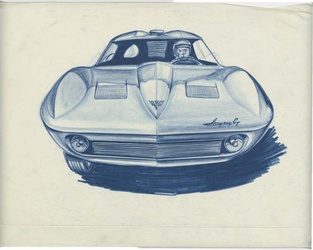
|
Larry ShinodaLarry Shinoda (1930-1997) was born and raised in Northeast Los Angeles. His training in industrial design at Art Center College of Design, Los Angeles and his love of drag racing propelled him into a long career with the design departments of car companies such as Packard, Ford, Chevrolet, and GM. …
Untitled drawing (Stingray) by Larry Shinoda |

|
Larry Shinoda videoIn this video from the Drawing the Line exhibition, Larry Shinoda's sister and friend talks about his early family history, including at Manzanar during World War II, and his early love of cars that led to his incredible success as an automobile designer.
Drawing the Line video - Larry Shinoda |

|
Ben SakoguchiBen Sakoguchi (b. 1938) is a painter and printmaker who has lived in the Los Angeles area his entire life. After studying painting in the 1960s at the University of California, Los Angeles, he developed a distinctive style that is rooted in pairing a narrative painting tradition with a pop …
Orange Crate Label Series 1974-81: WWIII Brand (1974-81) by Ben Sakoguchi |

|
Ben Sakoguchi videoIn this video, Ben Sakoguchi talks about his parents and how the World War II camp experience affected them, his inspirations for his orange crate label paintings, and the way he works.
Drawing the Line video - Ben Sakoguchi |
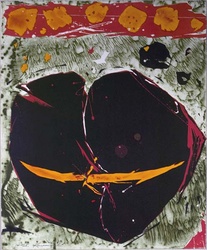
|
Matsumi “Mike” KanemitsuMatsumi "Mike" Kanemitsu (1922-1992) was born in Utah but raised by his grandparents in Japan until he was 16, when he returned to the U.S. He spent five years in the military during World War II, serving in Europe and spending time studying with artists in France after his discharge. …
Oxnard Madame (1961) by Matsumi “Mike” Kanemitsu |

|
Mike Kanemitsu videoIn this video, Nancy Uyemura talks about artist Matsumi “Mike” Kanemitsu's life as an artist and his artwork, and his role as an advocate and mentor to other artists in the local Japanese American community in Los Angeles.
Drawing the Line - Matsumi “Mike” Kanemitsu |

|
GIDRA magazineGidra was a monthly publication that called itself the "voice of the Asian American movement." Founded by University of California, Los Angeles (UCLA) students in April 1969, the magazine took a radically progressive political position, providing information about the movement not found elsewhere in the mainstream media. The magazine eventually …
GIDRA 1974 - Cover Page |

|
GIDRA videoIn this video, former Gidra staff Mike Murase, Evelyn Yoshimura, and Doug Aihara talk about Gidra magazine—how it started, how they worked, and the types of stories they covered.
Drawing the Line video - GIDRA |

|
Robert A. NakamuraRobert A. Nakamura (b. 1937) is a filmmaker, teacher, and community activist. In 1970, he co-founded Visual Communications, now the oldest Asian American media center in the U.S. His landmark films include Manzanar (1972), an experimental documentary that revisited childhood memories of the World War II incarceration, and Hito Hata: Raise the Banner (1980), …
Cemetery Monument at Manzanar by Robert A. Nakamura |

|
Robert A. Nakamura videoIn this video about photographer & filmmaker Robert A. Nakamura, he talks about how he was inspired by Gidra magazine to become active in the Asian American Movement, and then became involved in filmmaking, creating the film Manzanar in 1972, and helping to found Visual Communications.
Drawing the Line - Robert Nakamura |

|
Qris YamashitaQris Yamashita (b.1951) is a graphic designer and artist whose work has formed a visual identity for the Japanese American and Asian Pacific American community. Her posters, books, flyers, and T-shirts have been crucial in promoting a sense of community and solidarity. She successfully synthesizes traditional Japanese and contemporary Western …
1980 Little Tokyo Mochitsuki poster |

|
Qris Yamashita videoQris Yamashita talks about how she has used her skill as a graphic designer and artist to support and promote the Japanese American community designing posters for mochitsuki, obon, and other events.
Drawing the Line - Qris Yamashita |

|
Nobuko MiyamotoNobuko Miyamoto (b. 1939) is a dancer and musician who found her political and artistic voice in the Asian American movement. JoAnne Nobuko Miyamoto began her career as a dancer on Broadway in Flower Drum Song and in films like West Side Story and The King and I. After working with director …
Nobuko Miyamoto and Chris Iijima |

|
Nobuko Miyamoto videoVideo of Nobuko Miyamoto talking about how she started dancing from a young age, became a dancer and performer in Broadway musicals, and how meeting Yuri Kochiyama led to her involvement in the Asian American Movement and of being in service to the community through her art.
Drawing the Line - Nobuko Miyamoto |
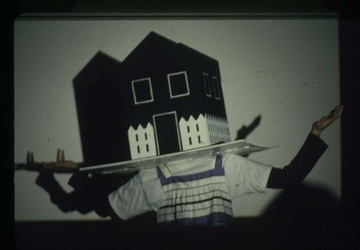
|
Linda NishioLinda Nishio (b. 1952) grew up in Los Angeles and attended the University of Kansas and Rutgers University, where she developed a multimedia art practice that involved photography, video and film, bookmaking and live performance. Her work centers around the definition and redefinition of self—exploring the ways that we see …
“Ghost in the Machine” (1981), Linda Nishio |

|
Linda Nishio videoVideo of Linda Nishio talking about how she developed as a feminist performance artist, including the piece Kikoemasuka which makes a statement that not all Japanese Americans are the same, and how her performances were like self-portraits.
Drawing the Line - Linda Nishio |
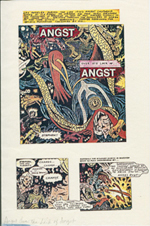
|
Bruce YonemotoBruce Yonemoto (b. 1949) has explored the relationship between mass media and the politics of identity in his work for many years. In his first classes in Ethnic Studies as a student at University of California, Berkeley, Yonemoto discovered an interest in his Japanese heritage. Following graduation, he spent three …
Angst over the Lack of Angst (1977) by Bruce Yonemoto |

|
Bruce Yonemoto videoBruce Yonemoto talks about his parents and early life in a farming community, studying at UC Berkeley in the late 1960s where he was involved in the start of Asian Studies classes and research, studying in Japan for 3 years, getting his MFA at Otis College in Los Angeles, and …
Drawing the Line - Bruce Yonemoto |

|
Norman Yonemoto videoNorman Yonemoto (brother of Bruce Yonemoto) talks about how his mother talked about their World War II experience and the influence of those stories on him, and the making the Second Campaign film.
Drawing the Line - Norman Yonemoto |
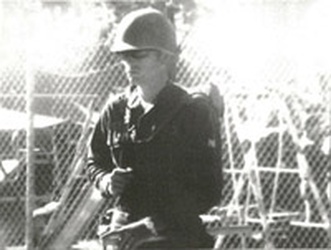
|
Norman YonemotoNorman Yonemoto (b. 1946) has always been fascinated with the way that techniques of filmmaking can be used to affect an emotional response. He received an MFA in directing from the American Film Institute, and an undergraduate degree at the University of California, Los Angeles, where he used film to …
Second Campaign film still |
 JANM
JANM
 "Transpacific Borderlands" Artist Profiles
"Transpacific Borderlands" Artist Profiles 2013 JANM National Conference - "Speaking Up! Democracy, Justice, Dignity"
2013 JANM National Conference - "Speaking Up! Democracy, Justice, Dignity" Drawing the Line: Japanese American Art, Design & Activism in Post-War Los Angeles
Drawing the Line: Japanese American Art, Design & Activism in Post-War Los Angeles GIDRA: April 1974 issue
GIDRA: April 1974 issue GIDRA: February 1973 issue
GIDRA: February 1973 issue GIDRA: January 1971 Issue
GIDRA: January 1971 Issue GIDRA: April 1969 issue
GIDRA: April 1969 issue The 21st Century Museum: Significant artifacts selected by Japanese American National Museum Volunteers
The 21st Century Museum: Significant artifacts selected by Japanese American National Museum Volunteers 全米日系人博物館 『コモン・グラウンド - コミュニティの心』
全米日系人博物館 『コモン・グラウンド - コミュニティの心』
 Journal feed
Journal feed
